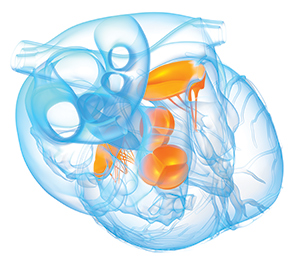Advancing the Management of Valvular Heart Disease
When it comes to conversations with patients about valvular heart disease, I find these discussions expanding as the options for the treatment of valvular disorders increase rapidly for both physicians and patients. Mitral commissurotomy became popular in the 1960s for selected patients whose lesion was primarily mitral stenosis with little regurgitation and the chordal apparatus was still intact. The advent of heart bypass opened a new world of heart valve surgery, where surgeons could replace the aortic, mitral or tricuspid valve and relieve the severe volume or pressure overload that was common before this surgery.

A decade of valvular heart surgery followed, as many patients with severe rheumatic valvular heart disease received mechanical heart valves that restored cardiac function to normal. Newer tilting disk valves now offer a backup if needed. Mechanical valves were quickly superseded by tissue valves that in many cases do not require long-term anticoagulation. Tissue valves also improved with better bioprosthetic materials and methods for implanting the valve.
We are now moving into an era with numerous new solutions for valve repair and replacement that promise to revolutionize the field of heart valve therapy. An aortic valve can be implanted using percutaneous techniques that eliminate the need for surgery. Transcatheter aortic valve replacement (TAVR) has grown from an occasionally used procedure in high-risk patients to nearly routine use of percutaneous aortic valve replacement in even lower-risk patients. Valve designs now accommodate bicuspid and regurgitant valves. Replacing a deteriorated TAVR valve with another TAVR valve is yet another strategy for maintaining long-term valve function.
The mitral valve has enjoyed less success in non-surgical repair and replacement than the aortic valve. Yet, we can reduce the severity of mitral regurgitation by clipping the two regurgitant leaflets together to reduce the size of the regurgitant orifice. Newer percutaneous mitral valve replacements are under development in Europe and the U.S that will provide a more definitive solution to mitral regurgitant valves. Robotics also plays a role in improving the safety and efficacy of mitral repair and replacement. Many patients now have their mitral valve repaired using robotic techniques that minimize surgical trauma and shorten hospital stays.
"We are now moving into an era with numerous new solutions for valve repair and replacement that promise to revolutionize the field of heart therapy.” — Alfred A. Bove, MD, PhD, MACC
With these great advances in technology, one wonders how far we can go in treating valvular heart disease. Ideally a patient with a damaged aortic valve would have the valve fully restored to normal function without the need for anticoagulants or other medications. This step requires the development of human tissue valves. Laboratories around the world are developing tissue valves grown in culture that will ultimately result in a fully functional human tissue valve that can be used to replace a damaged aortic, mitral, tricuspid or pulmonic valve.
Improving right-sided hemodynamics can be accomplished with a heart valve placed in the inferior vena cava at the right atrial junction. The valve directs the regurgitant volume into the right ventricle, and reduces right-sided volume overload. Every year brings new ideas on how to manage regurgitant and stenotic heart valves to restore hemodynamics to normal and improve clinical care for patients with valvular heart disease.
For the clinical cardiologist, these newer valves will offer new challenges for patient management and require an understanding of potential complications. The distant future suggests that we could create heart valves that contain active components, like small motors and positioners with microcircuit controls that could instantaneously modify the load state and contractile function to optimize the functional state of the myocardium. Valvular heart disease continues to be an exciting area of cardiology that will challenge our technical and clinical skills far into the future.
Alfred A. Bove, MD, PhD, MACC is professor emeritus of medicine at Temple University School of Medicine in Philadelphia, and a former president of the ACC.
Keywords: ACC Publications, Cardiology Magazine, Anticoagulants, Aortic Valve, Bicuspid, Clinical Competence, Heart Valve Diseases, Heart Valve Prosthesis, Heart Ventricles, Hemodynamics, Length of Stay, Mitral Valve, Mitral Valve Insufficiency, Mitral Valve Stenosis, Myocardium, Pulmonary Valve, Robotics
< Back to Listings
